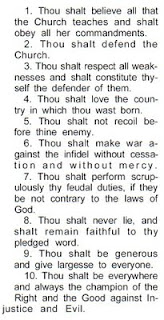This last post contains some ideas that could be spread throughout a long-term campaign. If the imagined world has clerics and "real" gods that respond to clerical prayers, then I think it's worthwhile to make some decisions about what the gods are really all about.
This certainly doesn't need to be done at the START of a campaign. To an extent, I agree with both James Mal and Fritz Leiber that a DM's knowledge of the world should grow and widen as the PCs' sphere of influence grows and widens. But if the DM prefers one of the weirder options below, it may be fun to weave in subtle hints about the truth from early on....
Thus, there are two very fundamental questions that PCs may eventually care to have answered:
- Can the gods be killed?
- Can mortals become gods?
1. Vanilla Polytheism. The gods created the world and sustain it. They draw some power from human worship, but they can exist without it.
2. Autonomous. Worship doesn't help or harm the gods; the boons they bestow on clerics are the result of pure altruism.
3. Parasites. Gods need human worship to survive, and their power increases and decreases with the number and fervency of their worshipers. It's self-interest for them to play an active role in the lives and fortunes of their worshipers.
4. Vorlons/Shadows. They are advanced alien beings who stick around in order to guide humanity. But will humanity eventually decide their guidance is no longer desired?
5. Cacogens. They are advanced alien beings who don't want to get TOO involved with humanity, lest we lose hope in ourselves. But sometimes they just can't resist inserting themselves into human events.
6. Apotheotes. All gods were mortal once. They either ascended gradually, BECMI style, or were granted godhood by ones that climbed this path before.
7. Askewniversals. There is one over-arching deity, omnipotent, omnipresent, and onmibenevolent, who occasionally deigns to interfere (or set things right) in the mortal world... usually via skee-ball. Otherwise, the earth is a battleground for good and evil spirits that often demand worship or other assistance from mortals.
8. Lovecraftians. The singular transcendent power is named CHAOS, and he/she cares not for us in the least. Some lesser powers rebel and try in vain to create order; others feed the chaos by setting mortal against mortal.
9. Zeistians. Nobody knows what created the universe, but there are multiple immortal beings. They feel an instinctual drive to murder one other, because in the end there can be only One (God).
10. Turtles all the way down. It's vanilla polytheism, as above, but the gods themselves worship another set of gods, who in turn worship another set of gods, and so on. Is there someone, or something, that worships humanity?
11. Landru. God is a sentient computer, buried far underground, the sole survivor of the pre-apocalyptic age.
12. Elementals. Everything in the physical universe has a "nature spirit" counterpart. When the thing itself dies, the spirit ceases to exist. (This doesn't rule out long-lived powers that appear omnipotent and transcendent to us: after all, if the ocean has a spirit, then so does the Earth, the Sun, the Solar System as a whole, the Milky Way Galaxy, and so on...)
13. Titanomachians. There ain't room for more than one generation of polytheistic deities in here. It looks like war up on the holy mountaintops. But by choosing WHEN the big war happens, in relation to the PC's campaign, one can impart a very different flavor to these supernal proceedings:
- Maybe the new gods just recently overthrew the old ones. It's a happy, joyful springtime of the world... but too bad about those Atlanteans who got caught in the shuffle...
- Maybe the war is just about to start. A new band of happy-go-lucky worshipers has come dancing into town. Nobody seems to be taking this new god "Zagreus" too seriously, but they're about to!



















